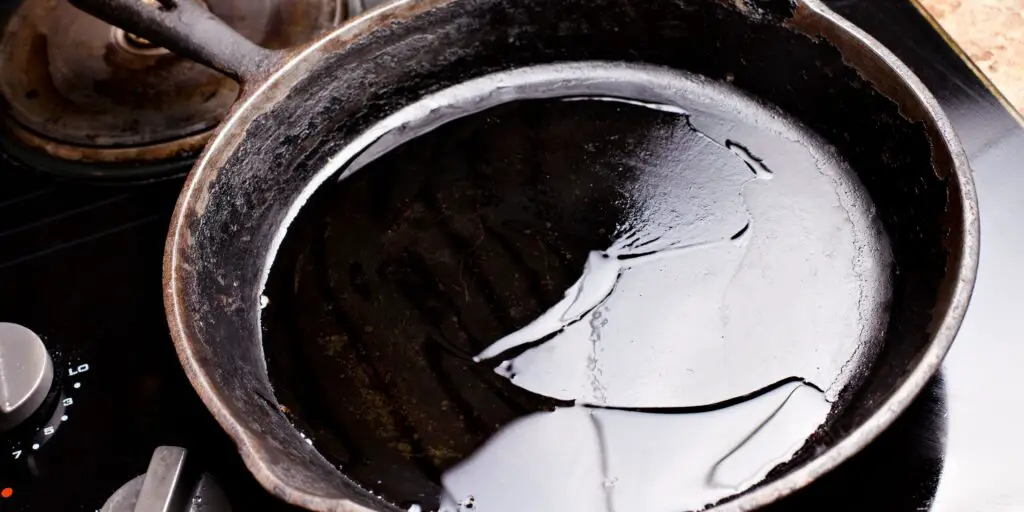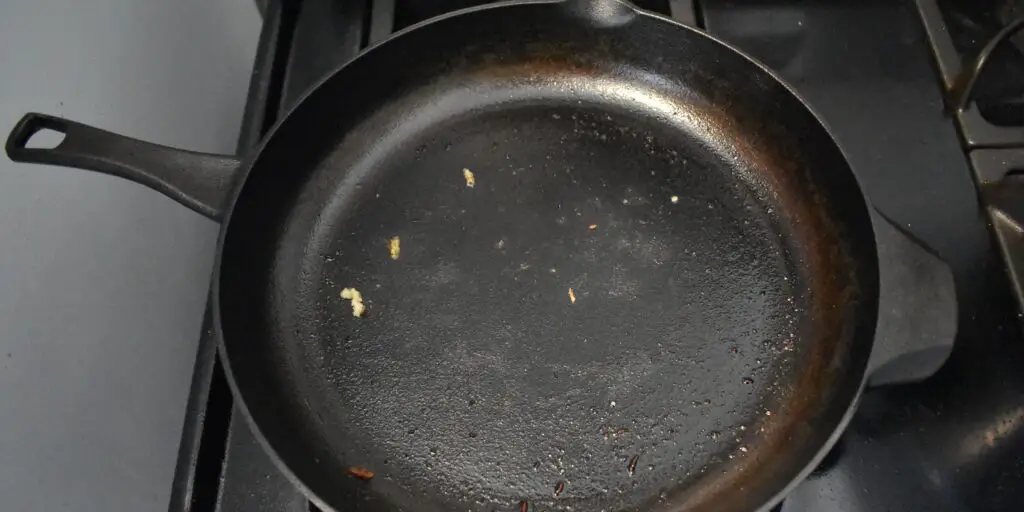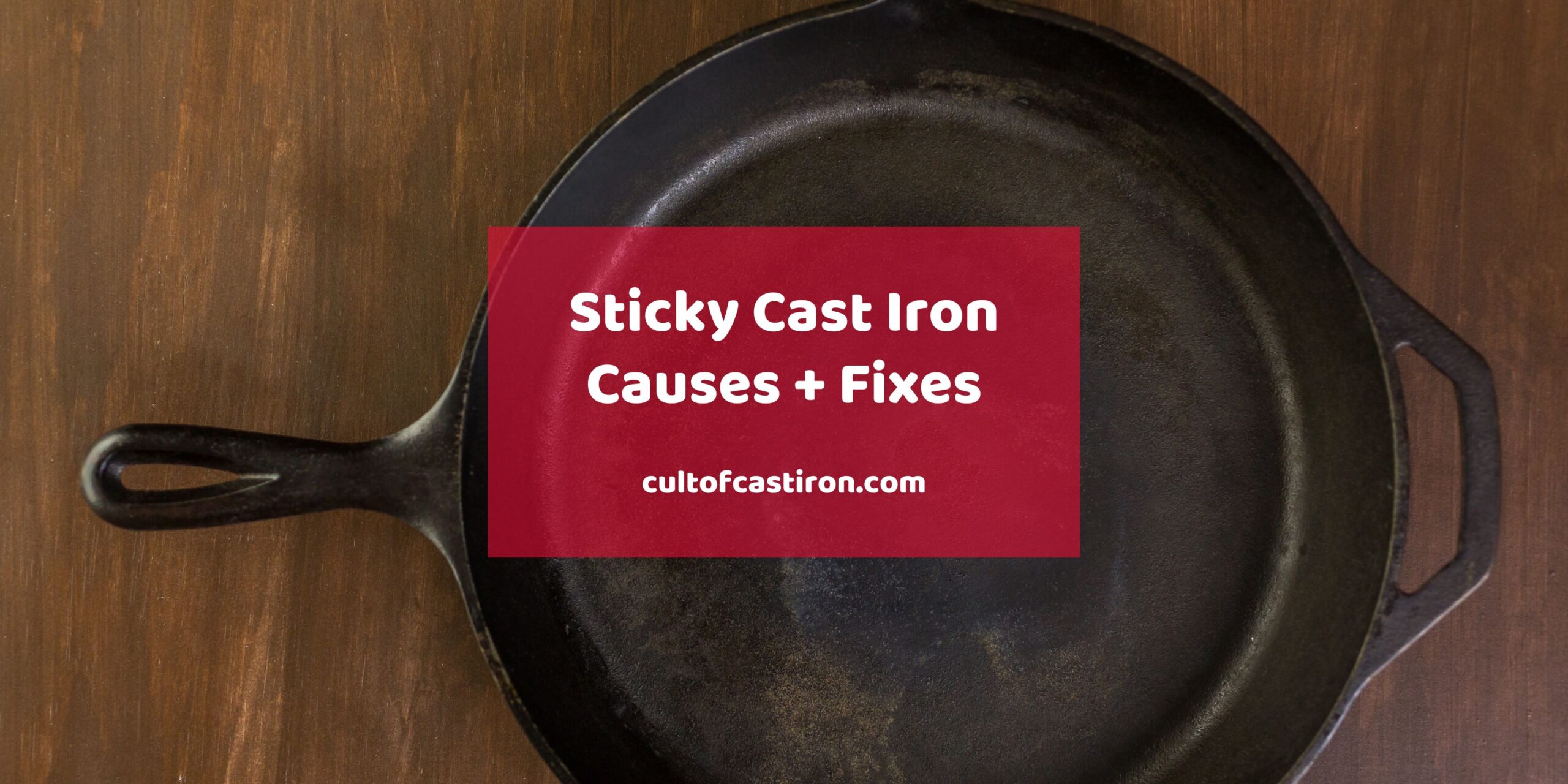Cast iron pans, while lauded for their durability and versatility, also have an unfortunate reputation for being finicky. While I disagree with that notion, I do understand where the naysayers are coming from. Truth is, if you mess up the cleaning or the seasoning process, you will end up with a sticky cast iron pan that’s going to haunt you during your next cooking session.
The primary reason why your cast iron pan is sticky is because of improper cleaning or seasoning – you may have put too much oil, or you’ve used the wrong type of oil. Also, the oil may not have reached the right temperature and thus it failed to polymerize. Whatever the case, this predicament can be easily reversed in a few simple steps.
Keep reading as we take a more in-depth look at why your cast iron pans get sticky, simple ways to remove gummy residue, and how to prevent your cast iron from becoming sticky in the future. But first, we must understand the culprit of this predicament: the seasoning.
A Background on Cast Iron Seasoning
The seasoning is a thin layer of carbonized oil that coats the cast iron pan. It has two functions – protect the bare cast iron from the elements and serve as a slick surface to cook on.
This layer is formed through the process of polymerization. In the context of cast iron cookware, polymerization refers to bonding multiple small fat molecules in the oil into a larger and more complex molecule called a polymer. This process is brought about using the right amount of heat.
There are many options when it comes to the oil used for seasoning a cast iron pan. As such, each has its own characteristics and smoking points – these factors can affect the stickiness of your seasoning as we will discuss later.
What Should a Properly Seasoned Cast Iron Pan Look Like?

A properly seasoned cast iron pan should have a proper sheen to it – not too greasy or too dull – and it must be free of rust. It should also exhibit relatively good non-stick properties. As for the seasoning itself, it should not be flaking or peeling. More importantly, the patina should not be splotchy – splotchy-ness is one of the top indicators that a cast iron pan is sticky.
So what, then, is causing this?
5 Reasons Why Your Cast Iron Pan is Sticky (and 5 Solutions To Keep Them from Sticking)
There are many reasons why your cast iron pan’s surface has become sticky. Most of these reasons are rooted in improper seasoning and cleaning. However, less-than-ideal storage practices and cooking with the wrong ingredients can also be the culprit. Try to retrace your steps to identify which of these reasons are the root cause of your problem.
1. You’ve put in too much oil

Putting in too much oil on a cast iron pan is detrimental as the excess oil will pool on the surface of the pan which may not polymerize properly. This will result in the oil turning into a sticky black residue that is halfway from being polymerized.
You’ll know that you’ve put too much oil in the pan when the patina looks splotchy and wet.
The Solution: Use less oil after cleaning a dirty cast iron pan or when you’re putting on a fresh coat of seasoning on your pan. There is no rule set in stone as to exactly how much oil you should apply – it all depends on the size of your pan, so just go by eye!
With that said, let me share with you some of the visual cues I look for to know if I’ve applied an appropriate amount of oil on my cast iron cookware:
- Not too shiny, not too lackluster
- No dull areas
- No surface rust
To take the guesswork out, I opt for an inelegant-yet-effective solution: after I’ve applied a fresh coat of oil on the pan, I rub the entire thing over with a clean rag to take off as much excess oil as I can. After that, the pan is ready either for storage or for the seasoning process.
2. You did not leave the pan face-side down while seasoning
For most people, seasoning a cast iron pan involves placing it upside down in an oven for an hour. They position the pan face-side down to let the excess oil drip down to a catcher below. However, leaving them face-side up will cause excess oil to accumulate in particularly depressed areas on the surface. And as discussed in the previous section the excess oil can turn into a sticky black goo when not polymerized properly.
The Solution: Just turn your pan face-side up while seasoning in the oven. A covered grill that can accommodate the pan will also work.
For those who only have a stovetop at their disposal (like I do!), you can also place your pan face-side down on top of the burner while seasoning. However, this may get tiring and cause burns when you’re not careful. What I do is I leave the pan face-side up – but I wipe the pan whenever I see excess oil pooling on the surface. This should go without saying, but be very careful while doing this! I wear oven mitts especially on my wiping hand to prevent it from getting burned.
3. You did not clean the pan well

A cast iron pan should be reasonably clean before going into the seasoning process lest it should come out sticky. If food particles and debris are left on the surface of the pan, they may accumulate oil in their vicinity, which leads to pooling, and thus, stickiness.
Moreover, leftover grease from animal fats is detrimental to building a strong layer of seasoning – this will be discussed in full in the next section.
The Solution: Put in some elbow grease and scrub the surface of the pan with a chainmail scrubber or a plastic brush to take off as much stuck-on food as you can. You can also use baking soda or salt to act as a mild abrasive for particularly stubborn spots.
4. You’ve used saturated fats for seasoning
What kind of oil you’re using will have a large bearing on whether your cast iron will become sticky or not. These can be categorized into two broad categories: saturated fats and unsaturated fats.
Saturated fats mostly come from animal fats like lard, butter, and other rendered fats. Some plant-based oils like coconut oil and palm oil are also under this category. Meanwhile, unsaturated fats mostly come from plant sources like olive oil, canola oil, and avocado oil.
Of these two, unsaturated fats are the better type of oil for use in seasoning your cast iron cookware as they are more reactive, which means that they can form the polymerized chains necessary to produce a great layer of seasoning. While saturated fats can still be used for seasoning, unsaturated fats just do the job better.
The Solution: The easiest thing to do here is to switch to unsaturated fats.
However, if you’d like to continue using lard or any other type of saturated fat to season your pan, then you should make sure to melt these fats first before application (saturated fats tend to solidify at room temperature). Rubbing them on the pan in their solid form will likely result in melted fat pooling on the surface during the seasoning process, and as discussed earlier, that is one of the primary causes of stickiness in a cast iron pan.
5. You’ve failed to reach the oil’s smoke point
Fat molecules are the building blocks needed to create a cast iron pan’s seasoning. However, they need to be treated with enough heat to kickstart the polymerization process. This begs the question: how much heat is needed to polymerize cooking oils?
The answer is it depends. Each type of oil has what is called a smoke point, which is the temperature at which it starts to burn and produce smoke. If the temperature somehow does not reach the smoke point or if the pan was taken out of the heat before enough time has elapsed, you will end up with something that I can only describe as a halfway polymerized goo that will cause food to stick on the pan.
However, you must be careful with going past the smoke point of oils as this can result in you burning off your seasoning. Yes, burnt and ashy seasoning is not good for anyone.
The Solution: Apart from knowing the smoke point of your choice of oil, you must also ensure that your pan is being subjected to that temperature during seasoning. This may come in the form of simply choosing the right oven settings before starting the seasoning process. If you’re really meticulous, you can get a Bluetooth oven thermometer that can send you temperature reports on your phone.
Additionally, you should look for visual cues after pulling your pan out from the heat. If you see any signs of stickiness, scrub the ruined layer off and start again.
Can You Cook With a Sticky Cast Iron Pan?
Yes, you can cook in a sticky cast iron pan – but you probably shouldn’t. While your food will cook as usual, there are a few reasons why this is a bad idea.
First and foremost, your food will stick to the pan. Not only is this annoying to deal with, but it may also ruin the presentation of your dish. Some of the unfinished layers of seasoning may also latch onto your food, which will impart black specks on your meal. While these are not harmful especially in small doses, it could still ruin an otherwise great dish.
The sticky black residue on the pan may also prevent a new layer of seasoning from developing properly on the pan, so be sure to address your pan’s sticky situation first before you cook a meal. Luckily, fixing this problem is quite straightforward.
How To Fix a Sticky Cast Iron Pan in 3 Steps
Fixing a sticky cast iron pan is easier than you think – you’ll only need a few things and a lot of elbow grease to get the job done. These are the steps you should do to get out of your sticky pan situation:
1. Wash the pan with warm soapy water
The first step of fixing a sticky cast iron pan is by wetting it with warm soapy water and scrubbing it with a metal chainmail scrubber.
With that said. let us dispel a rumor: yes, you can use mild dish soap to clean your cast iron pan without it doing damage to the seasoning. In fact, I think that it is necessary in this case as the soap helps break down the halfway polymerized seasoning. You can also sprinkle mild abrasives like salt and baking soda while scrubbing to help you make quick work of the sticky residue on the surface of the pan. Rinse off the soap and the detritus once you’re satisfied.
2. Dry the pan thoroughly
After rinsing, you should ensure that the pan is dry before you apply a layer of oil on its surface.
With a rag, wipe the pan until there are no visible beads of water anywhere on its surface. You should also heat the pan on the burner for a minute or two so that water that was not wiped away will evaporate off the pan – ensuring that it is bone dry during oiling.
3. Apply a thin layer of oil to the pan
Now that the pan is dry, it is now ready to be oiled!
Put a few glugs of oil on the pan and rub it on every nook and cranny you can see. Make sure that there are no dull spots on the pan.
Once you’ve applied the oil all over the pan, wipe away any excess oils using a towel or a rag – you don’t want to repeat the same problem now, would you?
Note: At this point, you can put the oiled cast iron pan in storage if you do not have plans on seasoning it. But for those who plan to put a fresh layer of coating on their pan, here is a detailed guide on how you should season a cast iron pan.
Wrapping Up
While fixing a sticky cast iron pan is not a hard endeavor, I think we can all agree that prevention is better than cure.
If you’re still hungry for more information on everything about cast iron cookware, then be sure to check out the rest of the Cult of Cast Iron blog!

Miguel is a cast iron enthusiast from Cavite, Philippines. He works in the digital marketing field as a content marketing strategist. On the side, he manages a small online bookstore and tends to his plants.

